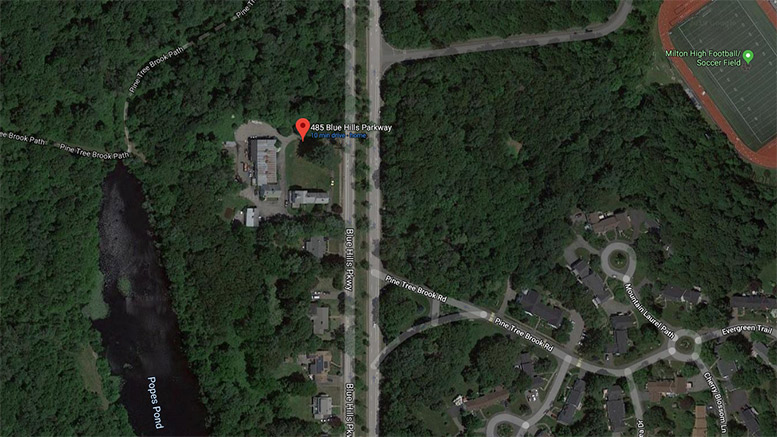Town draft response to Mass Housing regarding proposed Ice House project to be discussed at Jan. 22 meeting
Town draft response: not quite
Draft Comment Letter from the Town of Milton Select Board to Mass Housing re: The Icehouse, 485-487 Blue Hills Parkway Comprehensive Permit Site Approval Application
This draft will be discussed as an agenda item at the Wednesday, Jan. 22 Select Board meeting at the Council on Aging at 7:00 p.m.
Michael Busby
Relationship Manager
MassHousing
One Beacon Street
Boston, MA 02108
Reference: The Icehouse, 485-487 Blue Hills Parkway
Comprehensive Permit Site Approval Application
Dear Mr. Busby:
The Milton Select Board appreciates the opportunity to comment on the Project Eligibility/Site Approval application for a proposed 56-unit development at 485-487 Blue Hills Parkway. Our comments include, in addition to our own review, concerns presented to the Board at public meetings on December 18, 2019 and January 8, 2020 and submitted in writing by Town boards and staff and interested residents. From all the input received to date, we have tried to distill the information that we believe will be most relevant to MassHousing’s review of the plans from 485-487 BHP Trust LLC (Charles Bosworth). Many other comments we received will be more appropriate to address during the permitting process, if the project actually goes forward as planned. We hope it does not.
As a general comment, the Board hopes to continue working with the applicant to improve the concept for this site so that the developer’s need for a feasible project and the Town’s need for neighborhood services and amenities can be met. We believe we can achieve both ends, but not with the project described in the Site Approval Application.
Background
In 2016, Town Meeting voted to amend the Milton Zoning Bylaw by adding the “Parkway PUD” to encourage commercial development in this location. The PUD is an option available by special permit in an area zoned for single-family residential development, as evident from the
existing land use pattern along the Blue Hills Parkway. As you must have observed when you visited the site on December 11, 2019, there are no goods and services in this part of Milton.
Contrary to statements in the Site Approval application, the site is not walkable to a downtown or village center or retail, services or an employment center. In fact, the absence of services in this location was the basis for the Parkway PUD. Its main purpose was to facilitate construction of a small-footprint grocery store and coffee shop that would bring some basic amenities to the neighborhood. The PUD zoning also provides for offices, a small bank, and housing units comparable in scale to the existing multifamily use.
Throughout the rezoning process, the Town hoped to create a feasible development opportunity and a commercial reuse of the site that would blend with the neighborhood and respect the historic character of the parkway. The latter goal explains the PUD requirements for a deep setback from the road, together with the specific landscaping and building design standards found in the Parkway PUD zoning. The bylaw went through several iterations as Town boards and residents reviewed drafts, provided input, and helped to make it a plan for a modestly scaled mixed-use development. It offers a good solution for a site that supported a pre-existing nonconforming use for decades.
Appropriateness of Conceptual Design
You have asked us to comment on a proposal that contradicts the core objectives of the Parkway PUD. Unfortunately, the concept described in the Site Approval application and depicted on the plans from 485-487 BHP Trust LLC bears no relationship to the physical form of the neighborhood and disregards the character of the Blue Hills Parkway, a cultural resource listed on the National Register of Historic Places since 2003. If you have not already requested comments from the Massachusetts Historical Commission (MHC), we ask that you do so.
As situated on the site, the proposed three-story L-shaped building extends almost the full width of the lot just over 30 feet from the road. Referring to the typical front setbacks of homes along the parkway, the proponent’s architect claims that “continuing the existing datum edge of development was one of the driving factors of the proposed residential apartment project.”
However, this claim is a cynical use of Chapter 40B to justify a massive, monolithic structure that actually has nothing to do with the typical scale and setbacks of much smaller single-family and two-family dwellings found along this road. Moreover, while neighboring homes face the street, the proposed building will face a rear parking lot. What will be viewed from the parkway is the long, minimally differentiated façade of a building that has its back to the street. And, the proposed project promises to clear-cut the site, removing virtually all the existing vegetation that plays such an integral part in defining the view from the road. As you would have noticed on your site visit here, the mature landscaping on properties all around the site is a character defining feature of the neighborhood.
We are hard-pressed to imagine how MassHousing can find that “the conceptual project design is generally appropriate for the site on which it is located, taking into consideration factors that may include proposed use, conceptual site plan and building massing, topography, environmental resources, and integration into existing development patterns” (760 CMR 56.04(4)(c)).
Perhaps MassHousing has received more information than the applicant provided to the Town.
Renderings and perspective drawings would have helped us with our review and helped the public understand how this development will actually look when viewed from the road and surrounding properties. While these visualizations may come with an eventual comprehensive permit package, you are asking us to comment now on a development for which neither MassHousing nor the Town has enough information to conduct a preliminary review. Surely the applicant’s plans, in their present form, do not even align with MassHousing’s own Chapter 40B Design Guidelines.
Suitability for Residential Development
The Town does not question whether 485-487 Blue Hills Parkway is appropriate for residential development. The property is in the Residential B District, which allows single-family dwellings on lots of 20,000 sq. ft. or more. The proposed density far exceeds what Milton currently allows, but we recognize that density alone is not a valid reason to oppose a multifamily development.
The issue is the structure itself: a massive building with regimented breaks in the façade, having no precedents in the neighborhood or the Town as a whole, creating a three-story wall all along the street. Multifamily housing could work in this location with a reconceived approach to the building and an honest reckoning with what it means to face a historic landscaped parkway.
The over-arching goal of Milton’s recently completed Master Plan (2015) is to “preserve and enhance existing housing and become more proactive in providing affordable housing and meeting a variety of changing housing needs.” These needs are not lost on our Town officials or our community. However, Milton’s shortage of affordable housing does not justify imposing a poorly conceived, excessively large building on a parkway surrounded by much smaller dwellings and open land. The developer can do much better, and so can MassHousing.
Undeniably, Milton needs affordable housing. This is evident not only in the fact that our Subsidized Housing Inventory (SHI) falls below the 10 percent statutory minimum, but also in the supportive comments we received from our Affordable Housing Trust following their review of the Site Approval Application. We cannot claim the success stories that some Boston-area suburbs have had with tools such as Chapter 40R. However, we have adopted zoning to provide affordable housing and our zoning has worked. Today, the Milton Zoning Bylaw includes three provisions requiring affordable housing: the Parkway PUD, the Central Avenue PUD, and the Brownfields PUD. The Central Avenue PUD bylaw has facilitated two mixed-income developments: 36 Central, which is built and occupied, with two affordable units, 16 market-rate units, and three commercial tenants; and 131 Eliot Street, currently under construction, offering four affordable units, 34 market-rate units, and 4,000 sq. ft. of commercial space. It is not as though Milton has ignored its own housing needs and those of the Boston region. MassHousing needs to consider Milton’s efforts and find that while the site is appropriate, the proposed project falls short. (760 CMR 56.04(4)(b)).
Environmental Concerns
Several commenters questioned the impact of the project on nearby wetland and water resources, notably Popes Pond. We understand that if this development proceeds as a Chapter 40B proposal, the Conservation Commission will retain jurisdiction under G.L. c. 131, § 40 and the project will have to comply with the Massachusetts Stormwater Handbook and Stormwater Standards. Still, there are site planning needs that these state requirements do not address, and as you know, the Town will have no ability to require them once MassHousing issues a Project Eligibility Letter (PEL). If MassHousing plans to grant a PEL for this development, we ask that you include the following conditions of approval:
- Require the applicant to provide barrier-free public access to the trails around Pope’s
Pond; and - Prohibit any cuts into the Parkway median.
It is not enough for MassHousing to append to the PEL a long list of items the applicant “should” address during the comprehensive permit process. The experience of other communities demonstrates that while MassHousing acknowledges their comments, there is nothing binding on the applicant.
Application Errors
Many of the comments we received from Town boards and staff pointed out egregious errors in the Site Approval Application. At times, we all felt as though we were reviewing a cut-and-paste submission that borrowed from a proposal in a city or some other Boston-area suburb. If these kinds of errors do not matter to MassHousing, they should.
A developer who plans to take on the complexities and risk of a mixed-income housing development should take care to proofread an application and correct such basic errors as confusing homeownership and rental housing, describing a site as vacant when it actually contains existing buildings, or claiming that a Parkway PUD special permit had been granted when one was never sought. The developer ought to know the zoning district in which the property is located. The developer ought to know that public transportation is not available in this neighborhood. And certainly, the developer ought to know that the site is not located in a blighted area. If you do plan to issue a PEL, please require the applicant to assemble a more qualified team with a demonstrated track record of high-quality workmanship. What we have seen so far leaves us very concerned about the project’s ability to comply with all aspects of the Chapter 40B program.
Site Control
Finally, we urge MassHousing to require the applicant to provide evidence that the applicant actually controls the entire site shown on the plans. In response to a resident’s comment, we asked our assessor to confirm the boundaries of the property and the adjacent Town-owned land.
It appears to the Town that the applicant’s project encroaches on land owned by the Milton Conservation Commission. If that is the case, the site plan must be revised. We assume MassHousing will give the Town an additional opportunity to comment on the revised plan. If you have any questions or need additional information from the Select Board, please don’t hesitate to contact me or our Town Administrator, Michael Dennehy, at (617) 898-4845.
Sincerely,
Michael F. Zullas
Chair
Milton Select Board







Be the first to comment on "Town draft response to Mass Housing regarding proposed Ice House project to be discussed at Jan. 22 meeting"